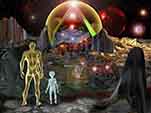Dear Friends, Patriots, et al. --
: About the alleged 500-year cycles: Did the jewish temple fall soon after Jesus' time?
The cycles noted here and by the Templars are based on the 22 and 1/2 year cycles of metals transformation, as discovered and evinced by the greatest scientific mind of the modern age, R. Buckminster Fuller of Harvard and the U.S. Naval Academy. Two complete cycles equals 45 years, so twenty complete cycles equals 450 years, and that is the key number (remembering that as we push backwards in time, the cycles become approximate).
Stepping backwards in the history of western civilization by increments of 450 years, we come to an extraordinary turning point in the Roman Republic in and around 250 years B.C. Just prior to that time, the Romans took control of Corsica and confronted the regional power of Tarentum; the key date here is 287 B.C., when "plebian" citizens gained full equality with the "patricians" in the governance of the Republic. Not too long afterwards, Rome annexed Sardinia and began its long struggle with the Carthaginians, one which proved fatal to the latter people and which was instrumental in the creation of empire. It was at this time that Cato the Elder and Publius Cornelius Scipio Africanus lived their famous lives and molded the new power of Rome.
Two hundred years later the fast-growing imperial Republic was riven by civil war -- with Julius Caesar finally defeating Pompey (who captured Jerusalem in 63 B.C.), at Pharsalia in the forty-eighth year before Jesus Christ. Caesar was proclaimed the dictator of Rome, he named his nephew Gaius Octavius as his heir, and the conspiracy to assassinate him succeeded just one year later. All in all, Julius Caesar had about four years of authority over the Roman imperial state, and the chaos which engulfed it after his death meant an end to true republicanism and the founding of a dynasty in Octavius, subsequently known as Augustus or Caesar Augustus. We now think with some authority that the actual birthdate of Judah bar Joseph, known as Jesus of Nazareth, was in or near 4 B.C., that he was baptized in 27 A.D. and that he died about three years later. Only ten years after that, one of the earliest Christian churches known was founded at Corinth.
The time of Julius Caesar is incredibly important because it was in 46 B.C. that the "Julian" calendar was adopted and the "leap year" was created. Thus the method of keeping time came more nearly into phase with the actual progress of the planet in its travels around the sun. It was a time of great learning and many accomplishments, even though slavery was the basic rule.
The Jewish people were constantly rebelling against one set of interlopers and conquerors after another in this era. They certainly made their mark in history with the rebellion which began in or about 66 A.D. or just two years after the first persecution of Christians. They enjoyed an incredible success at first, but the full fury of Rome fell upon them under the Emperor Vitellius and they were eventually crushed. The Temple was torn down and the city of Jerusalem sacked and mostly destroyed. Those Jews and their Christian cousins who survived fled or were forced into exile, mostly into Egypt, southern Greece and the cities of Asia Minor (where Hellenic Jews had lived for decades). Christianity took hold in Egypt -- and especially among the Greek-speaking peoples there, and by 600 A.D. it was one of the largest communities in the world.
The cycle which began roughly in 250 B.C. lasted until 200 A.D., at which time Rome was exceedingly wealthy, powerful, wicked and corrupt: at about that time, the Cult of Cybele was as popular as the obscure and formerly all-Jewish cult of the Messiah, and its followers apparently had a lot more fun, with their festivals and beliefs being widely embraced in Rome, while Christians suffered repeated persecutions followed by periods of quiet growth. Because so many educated Greeks were held as slaves in the Roman social system, the teachings of the Messiah were handed down in that language, and the Christian faith was often tolerated as being a Greek-inspired "burial cult."
: Rome fell about 450 AD.
Alaric captures Rome in 410, and then dies while moving south. The Vandals under Gaiseric become an even more potent force and take control of much of Spain. The Huns move into Pannonia and the Goths push the Vandals out of Spain, while the Ostrogoths take Dalmatia.
The Vandals sack Rome in 455 and then destroy the Roman fleet in 460, while the main body of their peoples occupy northern Africa. The Visigoths and the Suevi occupy Portugal and northern Spain. Mixed in this time, are the incursions of the Huns, who push the other tribes before them, winning many victories before withdrawing from western Europe in or about 470.
The last western Roman Emperors perish by 476 and that leaves the Barbarian Kings in control of much of their former empire, while the Byzantine section of Rome flourishes and remains strong.
Many of the pivotal events of each era of metals-cycling seem to fall in the mid-point of the 450 year timespan. In other words, at 225 years, or ten cycles of metalworking and reusage, great political and social events seem to occur. Thus, the American revolution falls exactly in the middle of the period which began in or about 1550 A.D. and which will conclude very shortly, if we choose the year 2000 as an end point. I would submit that the proper ending year is about 2012, or the end of the current 22 and 1/2 year metals cycle.






































